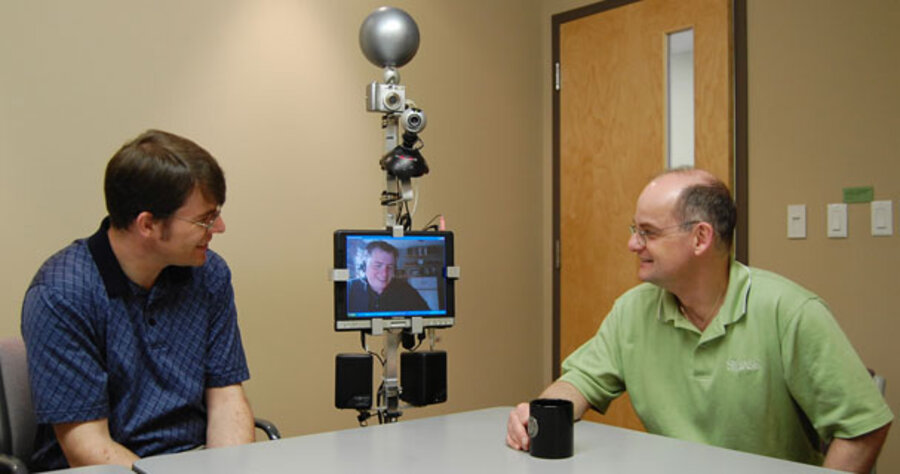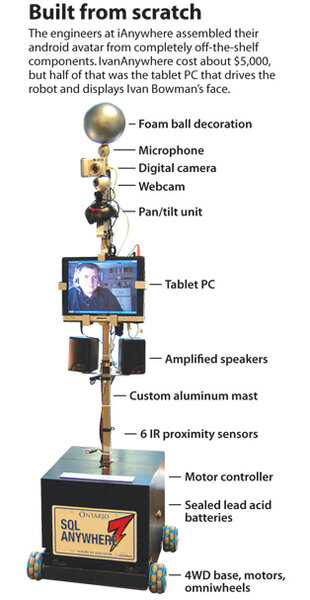Send your robot to work
Loading...
The hallways of software company iAnywhere in Ontario are pretty quiet. Beige walls muffle the faint rattle of programmers typing. Patterned carpet absorbs the sound of footsteps – well, unless it’s Ivan Bowman cruising down the hall. For him, a trip to the boss’s office involves revving his four-wheel drive.
Mr. Bowman is not actually here in Waterloo – he’s 800 miles away in Nova Scotia. But from his home, Bowman pilots a robot around the iAnywhere cubicles.
His office avatar is a lanky thing – often compared to a coat rack on wheels. Wires hang from its metal mast, connecting motors, speakers, and cameras. And mounted in the middle nests a laptop that shows a live look at Bowman working from home.
This novel approach to telecommuting allows him to code software from his living room, while still interacting with co-workers.
Bowman maneuvers the bot with a video-game controller that hooks up to his computer. By wiggling the dual joysticks he can swivel the webcam that acts as his eyes and steer the droid toward its destination.
This month is the first anniversary of when the robot, dubbed IvanAnywhere, first booted up. But the brainstorming began more than five years ago, when Bowman’s wife accepted a job in Halifax, Nova Scotia. While Bowman had to move to a different province, it didn’t mean he had to leave the company as well.
“He was too good of an engineer to let him go,” says Glenn Paulley, Bowman’s boss. “So we tried a few different configurations.”
First came simple telecommuting. Bowman stayed in touch with colleagues through phone calls, e-mails, and instant messages. But the relationship felt too detached. It was hard for either side to feel like Bowman was a part of the team, Mr. Paulley says – “out of sight, out of mind.”
They upgraded to a video porthole, which allowed Bowman to have face-to-face chats and meetings with co-workers huddled around the computer screen in his cubicle. But this had its own problems. The microphone would pick up conversations in the hallway that Bowman wanted to join, but couldn’t.
“I would hear that there was a misconception, one that I could have nipped in the bud, but I couldn’t just get up and walk over to them,” says Bowman. He didn’t want to yell to get their attention, and he couldn’t call until they returned to their desks, at which point the discussion was over.
The idea for a mobile robot came a year ago, when co-worker Ian McHardy brought a remote-controlled (RC) vehicle into work. Paulley joked that they should attach Bowman’s screen to an RC blimp and let him hover through the office like a bumblebee. They all had a good laugh, but this gave Mr. McHardy an idea.
He designed a heavy base loaded with circuits, wheels, and 50 pounds of motorcycle batteries – enough to get the robot through a full workday.
The heart of the machine is a touch-screen laptop, which collects information from all of the peripherals and transmits the video, sound, and sensor data from the office Wi-Fi, through the Internet, to Bowman’s home computer.
“The worst time is around 4 o’clock, when everyone gets home from school and the whole Internet slows down a bit,” he says. “That’s when the video gets a little erratic. It’s had a few collisions, especially with Glenn’s door.”
“Or my foot,” says Paulley, “which he ran over twice.”
Accidents are pretty rare. IvanAnywhere only clocks about 1.5 miles per hour and its proximity sensors cut power to the motors if objects get too close. These infrared sensors don’t always register everything, but this has its upsides – Bowman has been known to ram chairs to clear a path.
This mobile design has gone through a few revisions. The original cardboard box that covered the motors has been replaced by a black case with a fake license plate. A digital camera was added above the video webcam; now Bowman can click a button from home and the camera automatically sends him a high-resolution image of distant objects.
IvanAnywhere is still a prototype, says Paulley, and they have no intention of marketing the robot anytime soon – they’re busy enough with their current jobs. Several organizations are testing similar RC robots. They range from office bots, to NASA’s centaur-like “Robonaut,” and a hospital droid that lets soldiers in Iraq interact with their newborn children stateside. But the iAnywhere team believes they were the first to use a robot as the primary way that they interact with a co-worker.
“It’s now gotten to the point where we all really miss it if the robot is down,” says Paulley. “That’s really hard to explain to people outside of the office.”






